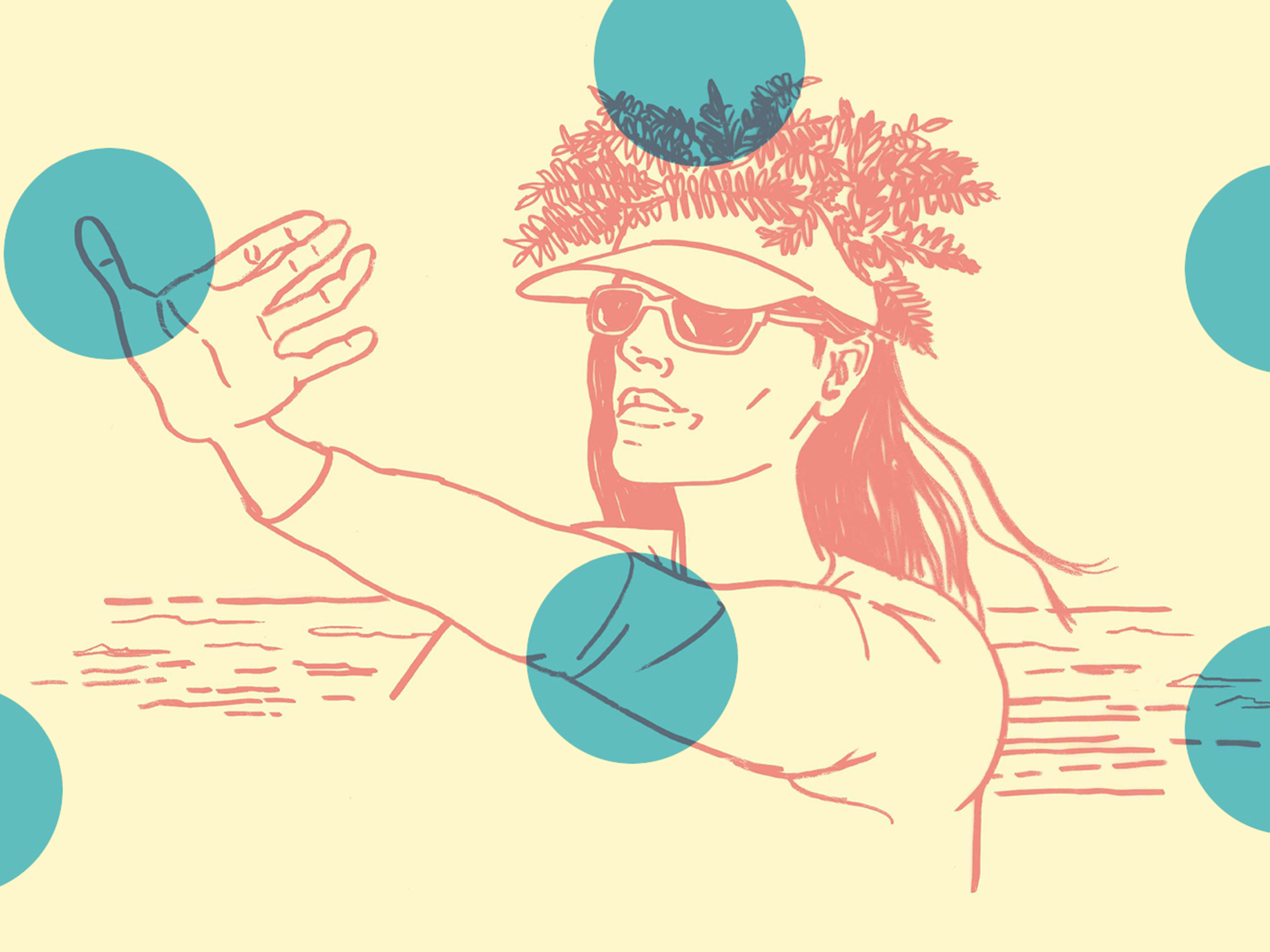THE MOST IMPORTANT moments of a day on Hōkūleʻa, a 62-foot-long deep-sea canoe, are sunrise and sunset. That’s when the navigator can know for sure where the sailboat is headed. In between, the swell—the direction of the waves—helps hold course, but “you have to have known what direction it’s coming from based on where the sun rose,” says Kaʻiulani Murphy. At night, the stars are an important guide: “The sky kind of gradually changes with your latitude,” Murphy says. But on cloudy days, it is impossible to find a true path without sunrise and moonrise.
Murphy is a watch captain for the Polynesian Voyaging Society, the oldest and best-known group dedicated to the wayfinding methods that first brought humans to Hawaii as early as 300 CE. Originally from Waimea, a small community on the Big Island, Murphy’s been navigating thousand-mile stretches of open sea without so much as a compass for decades.
In 1997, as an 18-year-old undergrad at the University of Hawaiʻi at Mānoa on Oahu, she attended a lecture by Nainoa Thompson, the Voyaging Society’s chief navigator. “I was just so enthralled with the stories he was sharing,” she says. By the following spring, she was doing her first trials on the open water. “I was one of the few people who didn’t get seasick,” she recalls. She cut her teeth as an apprentice navigator in 2000, when she served on part of the return leg of a trip to the remote Rapa Nui (Easter Island). She’s spent many of the days since then following the solar rhythm that led her ancestors across the ocean.
The founding members of the Polynesian Voyaging Society—which include historian Herb Kawainui Kāne, anthropologist Ben Finney, and expert canoer Tommy Holmes—crafted Hōkūleʻa in the mid-1970s. Knowledge of Hawaiian culture was at a nadir after decades of violent colonial influence that, among other things, denied or obscured the fact that ancient Polynesians sailed thousands of miles of open waters. “Hōkūleʻa was built at a time when I think we in Hawaii needed her most,” Murphy says. The boat’s design mimics that of the double-hulled vessels that once traveled more than 2,500 nautical miles from the Marquesas Islands and Tahiti. “When you step on board you almost feel like you’re stepping back in time,” Murphy says. “I think, This is what our kupuna, our ancestors, would have been sailing.”
While no one on Hawaii knew exactly how those first epic trips had unfolded, other Oceanic communities had maintained an unbroken chain of wayfinding knowledge. Traditional Micronesian navigator Mau Piailug offered to share the techniques his ancestors had preserved as oral history. In 1976, he joined Kāne, Holmes, and Finney on their newly built vessel and guided them along the historical route, which takes 20 days or more to travel.
Piailug passed on his skills to the Polynesian Voyaging Society’s navigators, who would eventually teach Murphy how to read the stars and swells. Hōkūleʻa—named for the North Star—has now sailed more than 140,000 nautical miles and has a larger sister named Hikianalia, constructed in 2012. The two canoes have traversed the Pacific on 10 major voyages, strengthening ties between Hawaiians and other Indigenous groups such as the Maori.
Growing up in a small community and watching her family farm taro, a traditional root vegetable, made Murphy eager to connect with pre-colonial Hawaiian culture. That fascination led her to Thompson’s lecture, and then into the swells. The group is “kind of what kept me on Oahu,” she says. But it also took her around the world—quite literally, as she served on several legs of a circumnavigation of the Earth in the 2010s. She eventually started teaching, first at Honolulu Community College and then at UH Mānoa, where she oversees the same class on ancient sailing she took at 19.
At sea, Murphy’s primary kuleana, or duty, varies. As watch captain, she coordinates the movement of the canoe and its crew, which ranges in number from eight to 14. Folks work in four-hour shifts; the rest of the time, they write in journals, practice music, craft gifts, and watch the ocean.
When Murphy serves as navigator, the job starts on land. The first step is plotting a detailed reference course—complete with an estimated schedule—using nautical charts and specs like currents and average wind. It’s something her ancestors wouldn’t have had on those first trips to Hawaii, but then again, today’s voyagers lack the multigenerational experience those explorers surely leaned on.
Once at sea, Murphy relies solely on ancient methods to keep to the plan. “As a navigator, you have to be really in tune to what’s going on in nature,” she says. For example, she often takes cues from seabirds: A pale, pigeon-like Manu o Kū means the boat is probably less than 120 miles from a coastline. The small, sooty noio has a much shorter range, so it’s a reliable harbinger of land. Seeing either helps the crew confirm its location relative to the islands and continents it cruises by.
Murphy says it’s “beautiful” to watch the renaissance of traditional Polynesian navigation. “In the beginning, there was a lot of trying to prove things, especially this ability to navigate,” she says. Today, multiple groups explore the seas in canoes modeled after their kupuna’s vessels. “Now we [have relearned] this knowledge, we want to make sure it is never lost again,” Murphy says. That means maintaining boats and building new ones, continuing the practice of voyaging, and teaching it to future generations.
But it’s not just about cultural preservation, she says—it’s about a way of connecting with the planet. For Murphy it all comes down to time with Hōkūleʻa, watching the sun rise and set, keeping an eye out for birds, and relying on the natural world for guidance. “There’s so much magic in that,” she says.
This story originally ran in the Fall 2022 Daredevil Issue of PopSci. Read more PopSci+ stories.

